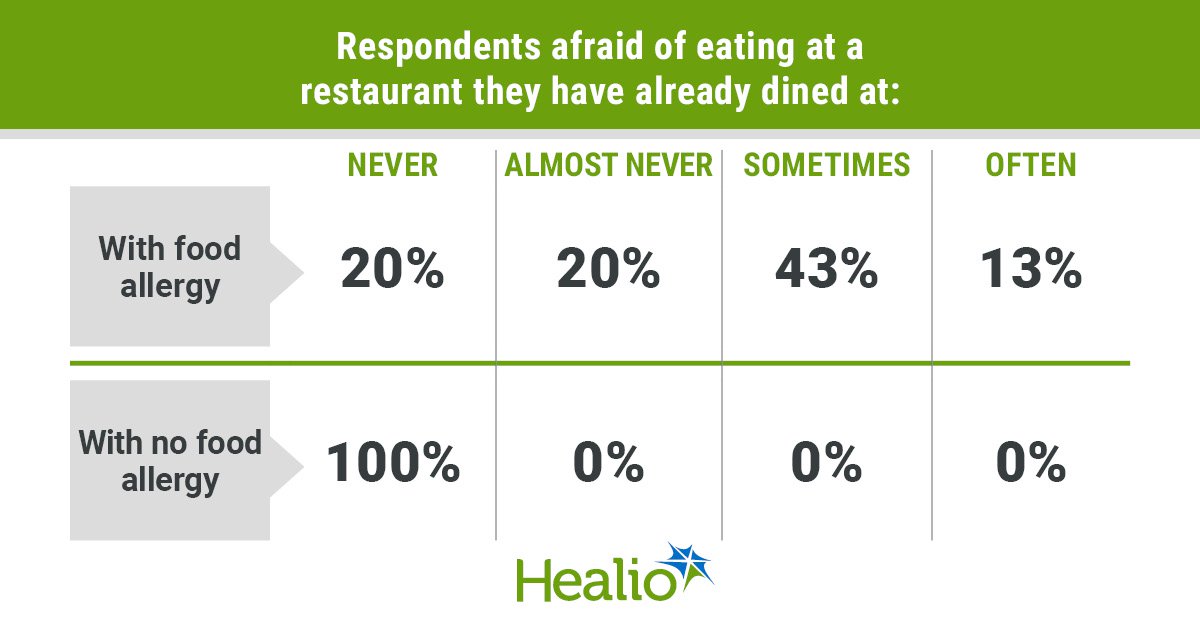August 18, 2025
4 min read
Key takeaways:
- 35% of teens with food allergy often were afraid of dining with an adult other than their parent.
- Most teens with food allergy were sometimes, often or almost always afraid to eat at school or camp.
Teenagers with food allergy experience more social discomfort than peers who do not have food allergy, with greater discomfort among those with multiple food allergies, according to a study published in Pediatric Allergy and Immunology.
These findings could help enable safe allergy management while improving quality of life for these patients, Carina Venter, PhD, RD, professor of pediatrics in the section of allergy/immunology at the University of Colorado Anschutz Medical Campus, and colleagues wrote.

Data derived from Blachar J, et al. Pediatr Allergy Immunol. 2025;doi:10.1111/pai.70134.
“I was approached by a teenager who has a family member with food allergies who wanted to do the study,” Venter told Healio.

Carina Venter
The researchers conducted a cross-sectional survey during October and November 2023. The survey was distributed via social media that was unrelated to food allergy as well as via the Food Allergy Research & Education email server.
The first section of the survey included 16 questions about demographics and medical history. The second section included 23 questions about comfort levels in various social situations. Responses used a five-point Likert scale, including never, almost never, sometimes, often and almost always.
The cohort included 46 respondents aged 13 to 18 years (median age, 16 years), with 34 (74%; 14 boys) reporting at least one food allergy and 12 (26%; three boys) reporting no food allergies.
“Even in familiar settings, like restaurants they had been to before or while under the supervision of other adults, many food-allergic teens still reported high levels of fear,” Venter said.
“This shows that anxiety around safe eating isn’t just about unknown foods or places,” she continued. “It can persist even in ‘safe’ environments, affecting their independence and quality of life.”
For the statement, “I am scared to eat food from a new restaurant,” 20% of the food allergy group answered sometimes, 23% answered often and 33% said almost always, compared with 91% who said never and 9% who said almost never in the group with no food allergy.
When asked if they felt fear when dining at a restaurant they had visited before, 20% of the food allergy group said sometimes and 43% said often, compared with 100% of the group with no food allergy who said never.
Also, 35% of the food allergy group and no one in the group with no food allergies said that they often felt scared when eating with an adult other than their parent.
In response to a question about feeling scared when eating at school or camp, 20% of the food allergy group said sometimes, 17% said often and 23% said almost always, but no one in the group without food allergies responded with often or more.
When asked if their parents or guardians prohibited them from eating school food, 53% of the food allergy group said yes, and everyone in the group with no food allergy said no.
Percentages of respondents who reread food labels include 33% who do so often and 37% who do so almost always in the food allergy group. In the group with no food allergies, 9% said they did so often, but no one said they did so almost always.
Percentages of respondents who worry about what they eat while traveling included 13% who do so sometimes, 37% who do so often and 17% who do so almost always in the food allergy group. In the group with no food allergies, 9% said sometimes, and no one said often or more.
Food allergy prevalence included 10 respondents who only had a peanut or tree nut allergy, 21 who had both nut and other allergies, and three who had allergies other than nuts. Additionally, 54.2% had an egg allergy in addition to their peanut and/or tree nut allergy, and every respondent with an allergy that was not a nut allergy was allergic to cow’s milk.
When asked if they were scared to eat at the homes of friends they have not visited before, 29% of those with nut and other allergies, 20% of those who only had nut allergies and no one who did not have a nut allergy said almost always.
Most respondents with three or more allergies were allergic to peanuts, tree nuts and eggs. Those with only one or two allergies were allergic to peanuts and tree nuts. Respondents with three or more allergies also were more likely to have asthma than those with fewer allergies.
Further, respondents with three or more allergies were significantly more likely to say they were sometimes (18%), often (41%) or almost always (29%) scared to eat at the homes of friends they have not visited before, compared with those with fewer allergies (8%, 31%, 15%, respectively).
The researchers cautioned that the limited sample size and somewhat selective recruitment process prevent these findings from full generalizability and recommended further studies with larger, more diverse and culturally varied samples.
However, they added, these findings indicate the negative impact that food allergies have on the lives of teenagers due to increases in social discomfort, particularly among those with multiple food allergies.
By understanding how food allergies impact the lives of teenagers, the researchers continued, providers can help support their quality of life while safely managing their allergies, particularly in food allergy transition clinics.
“For everyday clinicians, these findings highlight that food-allergic teens often experience significant and persistent anxiety about eating, even in familiar settings,” Venter said.
In addition to education about allergen avoidance, routine care should include mental health screenings, coping strategies and transition readiness for independent self-management, she continued.
“Clinicians should recognize that teens with multiple or hard-to-avoid allergens — eg, milk, egg — may need more intensive support and should consider integrating dietitians, psychologists and school/community advocacy into care plans,” Venter said.
Venter also called for future studies to include larger and more diverse samples to improve their generalizability and ensure balance between groups with and without allergy.
“They should also include objective measures such as confirmed accidental exposures and possession/use of epinephrine autoinjectors,” she added.
Further, these studies should stratify by allergy type for a better understanding of the differences in social comfort when foods are hard to avoid such as milk and egg or easier to identify such as nuts, Venter said.
Studies should additionally address cross-cultural factors such as differences in allergen labeling laws, dietary habits and the availability of safe foods, she continued, as well as track changes over time via longitudinal designs that reveal how the behaviors of teens with food allergy evolve into adulthood.
“This would provide a fuller picture of both the emotional and practical challenges faced by food-allergic teens and help tailor interventions more precisely,” she said.
For more information:
Carina Venter, PhD, RD, can be reached at carina.venter@childrenscolorado.org.












